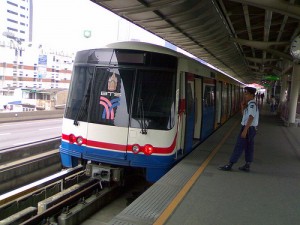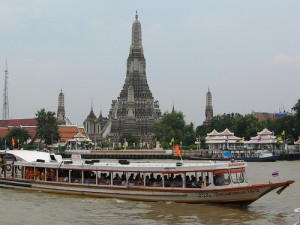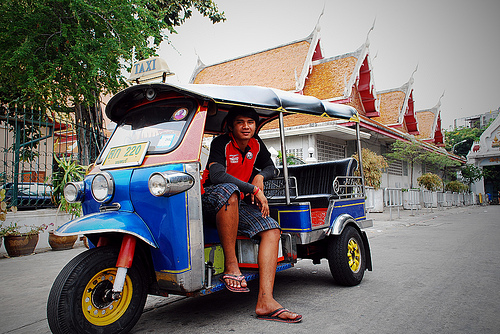 Bangkok is a crazy bustling city that never sleeps. During all hours of the day and night you will find pedestrians, taxis, tuk-tuk’s, buses, motorbikes and yes, the occasional elephant. Traffic in Bangkok can be chaotic and the transportation options can be intimidating. Here are some tips to help navigate your navigation options in the City of Angels.
Bangkok is a crazy bustling city that never sleeps. During all hours of the day and night you will find pedestrians, taxis, tuk-tuk’s, buses, motorbikes and yes, the occasional elephant. Traffic in Bangkok can be chaotic and the transportation options can be intimidating. Here are some tips to help navigate your navigation options in the City of Angels.
Taxis – Cheap & Comfy
The brightly painted taxis in Bangkok come in variety of colors but they all operate on the same metered fare system. A proper taxi will have a “Taxi-Meter” sign on the roof. Fares start at THB 35 (USD 1) and increase with both km driven and minutes standing in traffic. For about THB 100 (USD 3) you can take a taxi pretty much anywhere in central Bangkok. Always insist that the driver use the meter. If he wants to negotiate just let him drive away. Another taxi should be along within a few minutes.
From the airport – When traveling into Bangkok from Suvarnabhumi, Bangkok’s International Airport, a standard metered taxi should cost around THB 350 (USD 10) including tolls for the expressway. Upon arrival at the baggage claim passengers will usually be greeted by several smiling young Thai women holding up taxi signs enticing less savvy travelers to book a taxi for an exorbitant fare. Never book a taxi with anyone inside the airport unless you’re willing to pay double, triple or even quadruple the metered fare. If you’re new to Bangkok and are worried about successfully reaching your desired destination you can use the official taxi stand located on the ground floor outside of arrivals. For a surcharge of THB 50 (USD 1.50) you can tell the taxi attendant where you’d like to go. He will then write down your destination in Thai and provide it to your taxi driver. Alternatively if you know where you’re headed, you don’t want to wait in the long taxi queue, and you want to avoid the THB 50 surcharge, simply head up to the 4th floor departures level where you will find several waiting taxis that have recently dropped passengers for departing flights. However, beware that many of these drivers will attempt to negotiate a rate with you. Simply insist on using the meter and agree that you will pay the expressway tolls (approximately THB 70 or USD 2).
Tuk-Tuk’s – Pricey & Polluted (But Fun To Drive!)
 Most tourists in Bangkok can be found in the back of a tuk-tuk, a 3-wheeled open air taxi. Tuk-tuk’s are not metered so all fares are negotiated with the driver whose opening bid is usually 2 to 3 times the equivalent fare for a standard taxi in Bangkok. Now I don’t know about you spoiled travelers, but I would much prefer to sit in the back of an air-conditioned taxi for 1/3 the price, than to sit in the back of a tuk-tuk in the Bangkok heat while inhaling the exhaust from the surrounding traffic. That being said, as much as I prefer not to ride in the back of a tuk-tuk…I once sweet talked a tuk-tuk driver into letting me take the driver’s seat and I drove a tuk-tuk just for fun, but that’s another story for another post.
Most tourists in Bangkok can be found in the back of a tuk-tuk, a 3-wheeled open air taxi. Tuk-tuk’s are not metered so all fares are negotiated with the driver whose opening bid is usually 2 to 3 times the equivalent fare for a standard taxi in Bangkok. Now I don’t know about you spoiled travelers, but I would much prefer to sit in the back of an air-conditioned taxi for 1/3 the price, than to sit in the back of a tuk-tuk in the Bangkok heat while inhaling the exhaust from the surrounding traffic. That being said, as much as I prefer not to ride in the back of a tuk-tuk…I once sweet talked a tuk-tuk driver into letting me take the driver’s seat and I drove a tuk-tuk just for fun, but that’s another story for another post.
Motorbike Taxis – Fast & Frightening
 As a general rule I try to avoid the use of a motorbike taxi in Bangkok for the obvious safety concerns, but on days when I’m in a hurry and traffic is at a standstill, a motorbike can be my saving grace. The beauty of traveling on a bike is that you can easily navigate the gridlock rush hour traffic, knocking an hour or more off of your commute. In heavy traffic the commute from my office to my condo might take over an hour in traffic, while the same commute takes only 10 minutes on a motorbike. Though not metered, the fare for a motorbike is usually equivalent to the fare that a standard metered taxi would charge (without traffic). This means that during rush hour motorbikes are not only faster, but also less expensive than a standard taxi which would charge you for the minutes spending standing in traffic. As with all forms of transport that are not metered, simply agree on a fare before accepting a ride. The motorbike taxis are indicated by the colored vest worn by the driver (usually orange or pink).
As a general rule I try to avoid the use of a motorbike taxi in Bangkok for the obvious safety concerns, but on days when I’m in a hurry and traffic is at a standstill, a motorbike can be my saving grace. The beauty of traveling on a bike is that you can easily navigate the gridlock rush hour traffic, knocking an hour or more off of your commute. In heavy traffic the commute from my office to my condo might take over an hour in traffic, while the same commute takes only 10 minutes on a motorbike. Though not metered, the fare for a motorbike is usually equivalent to the fare that a standard metered taxi would charge (without traffic). This means that during rush hour motorbikes are not only faster, but also less expensive than a standard taxi which would charge you for the minutes spending standing in traffic. As with all forms of transport that are not metered, simply agree on a fare before accepting a ride. The motorbike taxis are indicated by the colored vest worn by the driver (usually orange or pink).
The driver will offer you a helmet although you’re not required to wear it. The helmets offered hardly provide any safety. They rarely fit and give the appearance that they wouldn’t provide any protection if you fell off the back of a toddler’s tricycle, much less a motorbike in Bangkok traffic. Nonetheless I recommend wearing the helmet, if not to save your head then to save your Thai Baht. Occasionally Thai police will stop the driver and fine the passenger for not wearing a helmet. This tends to happen more often at the end of the month when (allegedly) the police are running low on funds and looking for bribes by fining “farangs” (foreigners). If you plan to stay in Thailand for any extended period of time, and intend to take advantage of the motorbike taxis, I highly recommend buying your own helmet. A basic selection of helmets can be found at Big C department store (the Wal-Mart of Bangkok). If you opt to use the helmet provided by the driver, then I’d recommend you bring along a bandana or handkerchief to place inside the helmet for the obvious sanitary concerns.
Your Own Two Feet + the Sky Train and Subway
 Several areas of the city are connected by the BTS Sky Train and MRT Subway. The more popular Sky Train offers two routes, the Sukhumvit Line and the Silom Line. The trains run daily between 6:00 am and 12:00 midnight with frequent service throughout the day, and more trains during rush hour. Fares range from THB 15 (USD 0.50) to THB 40 (USD 1.30) and vary with distance travelled. Remember to hold on to your ticket as you’ll need to present it at the turnstile after exiting the train.
Several areas of the city are connected by the BTS Sky Train and MRT Subway. The more popular Sky Train offers two routes, the Sukhumvit Line and the Silom Line. The trains run daily between 6:00 am and 12:00 midnight with frequent service throughout the day, and more trains during rush hour. Fares range from THB 15 (USD 0.50) to THB 40 (USD 1.30) and vary with distance travelled. Remember to hold on to your ticket as you’ll need to present it at the turnstile after exiting the train.
For shorter distances the majority of central Bangkok can be easily navigated by foot. For the most part it’s a safe city and tourist areas such as Sukhumvit are safe to walk through even at night.
River Boats
 An often forgotten form of transportation in Bangkok is the river boat. For tourists visiting the Grand Palace or Wat Pho (home of The Reclining Buddha), or for the less cultured travelers looking to drink cheap liquor from a bucket on nearby Khao San Road, the river offers a scenic commute. Chao Praya River Express operates a regular boat service up and down the river with fares around THB 25 (USD 0.83). There are piers near many of the riverside hotels and near the Saphan Taksin Bridge BTS Sky Train station. Tickets can be purchased from staff at the pier. Additionally the Chao Phraya Tourist Boat serves those piers of interest to tourists with a full day unlimited pass for THB 150 (USD 5).
An often forgotten form of transportation in Bangkok is the river boat. For tourists visiting the Grand Palace or Wat Pho (home of The Reclining Buddha), or for the less cultured travelers looking to drink cheap liquor from a bucket on nearby Khao San Road, the river offers a scenic commute. Chao Praya River Express operates a regular boat service up and down the river with fares around THB 25 (USD 0.83). There are piers near many of the riverside hotels and near the Saphan Taksin Bridge BTS Sky Train station. Tickets can be purchased from staff at the pier. Additionally the Chao Phraya Tourist Boat serves those piers of interest to tourists with a full day unlimited pass for THB 150 (USD 5).


Leave a Reply